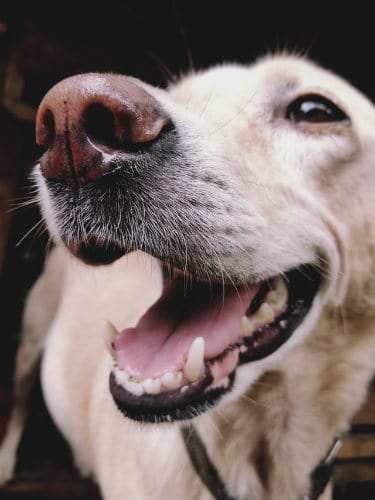A dog’s nose is wet thanks to the secretion of a special mucous that helps to absorb scent chemicals. This is partially responsible for a dog’s keen sense of smell.
Smell is a dog’s most powerful and important sense. Dogs rely on olfactory data to explore their worlds, and a wet nose helps to optimize the effectiveness of the dog’s olfactory system. A damp surface helps to attract and hold scent particles in place, making it easier to pick up odors while sniffing.
Dog noses function differently than human noses. In humans, smelling and breathing function through the same nasal passages. In dogs, tissue inside each nostril separates the two paths. This means that dogs breathe and sniff separately and can do both at the same time. Dogs also keep their noses close to the ground, often touching the things they’re sniffing; human noses, which are usually up in the air away from interesting scents, have no need to trap particles in moisture.
The secondary function of a dog’s nose is temperature regulation. Dogs don’t sweat like humans; they mostly dissipate heat through their paw pads and panting. A cool, wet nose aids in heat exchange as well.

3 Ways Dogs Keep Their Noses Wet:
1. By Secreting Mucus
The interior of a dog’s nose contain glands that produce thin, runny mucus that moisturizes the nasal canal and clings to the nostrils. This process also produces a watery fluid that evaporates to aid in cooling. This is why you may notice your dog’s nose dripping on a hot day or while he’s panting.
2. By Licking
Dogs lick their noses frequently and keep them covered in saliva. They do this in part to keep the nose clean of dirt, food, pollen and other debris. They also use their tongues to transfer scent particles from the nose to the roof of the mouth so the Jacobsen’s organ can be put to work. Dogs will moisturize their own noses through frequent licking. This is why your dog’s nose may dry out when he’s asleep.
3. By Picking up Moisture
Dogs investigate the world nose-first, and sniffing through leaves, damp grass, puddles and other environmental items. Ambient moisture in the air and environment can cling to a dog’s nose to aid in keeping it wet.
Some dogs will naturally have a dryer nose than others. Unless the nose is visibly chapped or the dog is showing other signs of illness, a dry nose is no cause for concern.
How Strong Is a Dog’s Nose?

There are up to 300 million sensory receptors in a dog’s nasal cavity; for a comparison, humans only have 6 million. These receptors help to make a dog’s sense of smell up to 100,000 times as strong as a human’s. Dogs also possess a scenting organ that humans don’t: the vomeronasal organ, also called Jacobsen’s organ. This organ is located within the dog’s nasal cavity and opens into the mouth behind the incisors, allowing a dog to both smell and taste certain scent signatures. In order to process all of this sensory information, dogs dedicate 40 times more brain power to scent identification than humans do.
What does it mean for a dog’s sense of smell to be so powerful? It means that dogs can sense vastly more information than humans can and may smell things completely beyond our comprehension. Dogs can identify specific smells in parts per trillion. That’s like being able to identify a teaspoon of sugar in two Olympic-sized swimming pools full of water.
This strong nose is what makes dogs ideal for scent detection. Dogs have been trained to sniff for bombs, drugs and even cancer. They have also been used for tracking everything from wild game to missing persons. Many important jobs rely on a well-functioning and healthy dog nose.
Does a Dry Nose Mean a Dog Is Sick?
Many people believe that a dry, hot nose is a sign of illness in a dog or that touching a dog’s nose is an effective way to gauge his temperature. Although there is some truth to this, it’s mostly just an old wive’s tale. A dry nose is not a reliable indicator of a dog’s health.
or that touching a dog’s nose is an effective way to gauge his temperature. Although there is some truth to this, it’s mostly just an old wive’s tale. A dry nose is not a reliable indicator of a dog’s health.
It is true that a dog with a high fever may have a nose that’s hot to the touch. However, their high body temperature will be noticeable throughout the body and not just at the nose. Moreover, a hot dog may still have a damp nose due to panting and fluid exchange in an attempt to reduce his temperature.
Dehydration can cause a dog’s nose to go dry. Sleeping, physical exertion, wind, sun exposure and many other factors can also affect a dog’s nasal condition. A better indicator of health is a dog’s temperature taken rectally. Signs of fever and illness such as listlessness and loss of appetite are important to watch out for as well.
Sick dogs may sometimes have excessively wet or runny noses. A dog’s mucus should be clear and thin. Mucus that is thick or discolored is often a sign of infection or the presence of a foreign body. Sneezing and coughing can be signs of an allergy or more serious illness, so it’s important to have your dog checked by a veterinarian if you notice these symptoms.
